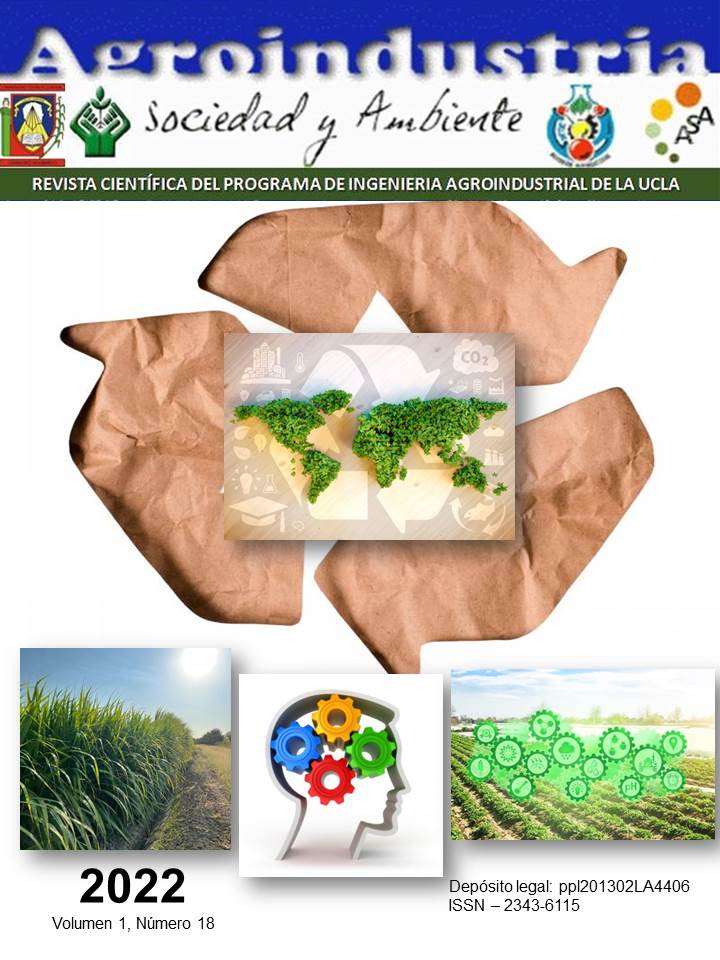Alternativas de recuperación, reúso, reciclaje y disposición final de la tierra de blanqueo gastadas en el proceso de refinación del aceite vegetal
DOI:
https://doi.org/10.5281/zenodo.6478821Palabras clave:
Tierra de blanqueo, arcillas, tecnología, publicaciones científicas, patentesResumen
Las tierras o arcillas de blanqueo son materia prima empleada en el proceso de refinación del aceite vegetal. Por sus condiciones físicas, posee características y propiedades que la hacen idóneas para la adsorción de ciertos componentes no glicéridos e impurezas, tales como carotenoides, clorofilas, ácidos grasos libres fosfolípidos e hidro-peróxidos, con ello se asegura que el aceite cumpla los requisitos necesarios para lograr la calidad del producto final. Las arcillas pueden llegar a retener entre 30-45 % del aceite refinado y una vez empleada en el proceso de blanqueo son dispuestas en vertederos a cielo abierto sin ningún método de valorización. Este comportamiento de consumir y desechar está cambiando y se comienza a visualizar a los residuos industriales como materiales con valor agregado que pueden ser aprovechados en distintos procesos y con ello promocionar economías secundarias a partir de las propiedades de los residuos. En este sentido, esta publicación identifica alternativas tecnológicas para la recuperación del aceite adherido en las arcillas, regeneración de las cualidades de las tierras para posterior uso en la industria de refinación y opciones de valorización del residuo para producción de biodiesel y biogás, complemento alimenticio para animales, fertilizantes, tratamientos de agua, agregados para la construcción, elaboración de jabones, entre otros. Información que fue extraída en la base de datos de la plataforma Patent Inspiratión para documentos de patentes y Web of Science para publicaciones científicas, bajo una estrategia de búsqueda que permitió identificar experiencias exitosas y comprobadas en distintos países.
Descargas
Citas
Ali B. et al (2016) Eliminación del colorante azul de metileno del agua por un biosorbente de tierra blanqueante agotado. Water Science Technology, Vol 74, Nº11.
Aragón, C.; De la Torre, E; Guevara, A; Haro, C. (2014). Regeneración de Arcillas de Blanqueo Empleadas en la Decoloración de Aceites Vegetales Comestibles. Escuela Politécnica Nacional, Departamento de Metalurgia Extractiva. REVISTA EPN, VOL. 34, Nº. 1. Quito, Ecuador.
Beshara, Abdelhamid et al (2016). Reutilización de tierra decolorante gastada mediante polimerización de residuos orgánicos. Water Science & Technology.
Chang I. et al (2010) Conversión de biodiésel de aceites residuales recuperados de la tierra de blanqueo agotada generada en las refinerías de aceite de soja. Patente: TW201006921A.
Cortez G, Lilian Camila; Torres Cruz, Sonia Liliana. (2016). Evaluacion de las alternativas para el aprovechamiento del residuo de la filtración de un aceite comestible. Universidad de la Salle. Bogotá-Colombia.
Enoch Y. et al (2004) Utilización de tierra blanqueadora activada residual que contiene aceite de palma en la producción de riboflavina por Ashbya gossypii. Journal of the American Oil Chemists Society.
García, E. y Suárez, M., 2001, “Las arcillas: Propiedades y usos”, http://www.uclm.es/users/higueras/yymm/arcillas.htm, (junio, 2 011).
Harvey, C. y Lagaly, G., 2 006, “Conventional Applications”, en Bergaya, F., et al., “Handbook of Clay Science”, primera edición, Elsevier, Amsterdam, Países Bajos, pp. 501, 507.“Home Thomson Reuters.” [Online]. Available: https://www.thomsonreuters.com/en.html.https://www.patentinspiration.comhttps://thelens.com
Ibrahim, A., 1 999, “Current and Prospective Export Market Developments for Palm Oil” en Leonard, E., et al., “Proceeding of the World Conference on Palm and Coconut Oils for the 21st Century: Sources, Processing, Applications and Competition”, American Oil Chemists’ Society, Illinois, USA, p. 30.
Jara, Dennys; Loor, Vivian. (2015). Recuperación de aceite en tierra de blanqueo usada a través de extracción con solventes para obtener biodiesel. Universidad de Guayaquil. Ecuador.
Klein, J., 1 986, “Methods for Recovering Oil from Spent Bleaching Earth” en American Oil Chemists’ Society y Baldwin, A., “World Conference on Emerging Technologies in the Fats and Oils Industry”, AOCS Press, Illinois,USA, pp. 169-171.
Lusas, E., 2 003, “Animal and Vegetable Fats, Oils and Waxes” en Riegel, E. y Kent, J., “Riegel’s Handbook of Industrial Chemistry”, décima edición, Kluwer Academic/Plenum Publishers, New York, USA, p. 290.
Navas Martinez, Feiber. (s/f). Recuperación de aceite en la tierra de blanqueo usada en la refinación de aceite palma. Alimentos Tecnológica FITEC. Colombia.
O’Brien, R., 2 009, “Fats and Oils: Formulating and Processing for Applications”, tercera edición, CRC Press, New York, USA, pp. 22, 44-78, 80, 85, 86, 103, 104.
Saleh, Y. y Zahrani, A., 1 999, “Techo-economical Evaluation of Oil Recovery and Regeneration of Spent Bleaching Clay”, Journal of King AbdulAziz University, 11 (2), 115.
Shim K. et al (2007). Método para producir vitamina b2 usando tierra decolorante gastada. Patente: KR100640548B1.
Smallwood, Norman (2015). Use of spent bleaching earth for economic and environmental benefit. AOCS. https://www.aocs.org/stay-informed/read-inform/featured-articles/use-of-spent-bleaching-earth-for-economic-and-environmental-benefit-may-2015.
Smallwood Norman (2013). US. Patent N.º [WO2013052357A2]: patente inspiration.
Taylor, D., 1993, “Adsorptive Purification”, en Applewhite, T., “Proceedings of the World Conference on Oilseed Technology and Utilization”, AOCS Press, Illinois, USA, pp. 152-161.
Taylor, D., 2 005, “Bleaching”, en Shahidi, F., “Bailey’s Industrial Oil and Fat Products”, sexta edición, Wiley-Interscience, New Jersey, USA, pp. 287-293, 302-308, 311, 312, 315, 316, 320-323.
Tsai, W., et al., 2 002, “Regeneration of spent bleaching earth by pyrolysis in a rotary furnace”, Elsevier, 63 (1), 157.
Zahrani, A. y Daous, M., 2 000, “Recycling of Spent Bleaching Clay and Oil Recovery”, IChemE (Institution of Chemical Engineers), 78 (B), 224.
Publicado
Cómo citar
Número
Sección

Está obra está bajo licencia Creative Commons Attribution-NonCommercial-ShareAlike 4.0 International License.
Derechos del/de autor/es a partir del año de publicación
Esta obra está bajo la licencia:
Creative Commons Reconocimiento-NoComercial-CompartirIgual 4.0 Internacional (CC BY-NC-SA 4.0)
Las opiniones expresadas por los autores no necesariamente reflejan la postura del editor de la publicación ni de la UCLA. Se autoriza la reproducción total o parcial de los textos aquí publicados, siempre y cuando se cite la fuente completa y la dirección electrónica de esta revista. Los autores(as) tienen el derecho de utilizar sus artículos para cualquier propósito siempre y cuando se realice sin fines de lucro. Los autores(as) pueden publicar en internet o cualquier otro medio la versión final aprobada de su trabajo, luego que esta ha sido publicada en esta revista.




